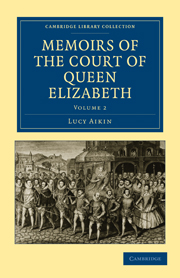Book contents
- Frontmatter
- CHAPTER XVII 1571 TO 1573
- CHAPTER XVIII 1573 TO 1577
- CHAPTER XIX 1577 TO 1582
- CHAPTER XX 1582 TO 1587
- CHAPTER XXI 1587 AND 1588
- CHAPTER XXII FROM 1588 TO 1591
- CHAPTER XXIII FROM 1591 TO 1593
- CHAPTER XXIV FROM 1593 TO 1597
- CHAPTER XXV 1595 TO 1598
- CHAPTER XXVI 1597 AND 1598
- CHAPTER XXVII 1599 TO 1603
- ON THE DOMESTIC ARCHITECTURE OF The Reign of Elizabeth
- INDEX
ON THE DOMESTIC ARCHITECTURE OF The Reign of Elizabeth
Published online by Cambridge University Press: 05 July 2011
- Frontmatter
- CHAPTER XVII 1571 TO 1573
- CHAPTER XVIII 1573 TO 1577
- CHAPTER XIX 1577 TO 1582
- CHAPTER XX 1582 TO 1587
- CHAPTER XXI 1587 AND 1588
- CHAPTER XXII FROM 1588 TO 1591
- CHAPTER XXIII FROM 1591 TO 1593
- CHAPTER XXIV FROM 1593 TO 1597
- CHAPTER XXV 1595 TO 1598
- CHAPTER XXVI 1597 AND 1598
- CHAPTER XXVII 1599 TO 1603
- ON THE DOMESTIC ARCHITECTURE OF The Reign of Elizabeth
- INDEX
Summary
During the period of English history included in our present survey, the nobility continued for the most part to inhabit their ancient castles; edifices which, originally adapted by strength of situation and construction merely to defence, were now in many instances, by the alteration of the original buildings and by the accession of additional ones, become splendid palaces. Among these it may be sufficient to mention Kennelworth, renowned for gorgeous festivities, where the earl of Leicester was reported to have expended 60,000 pounds in buildings.
Some curious notices of the habitations of the time are preserved in Leland's Itinerary, written about 1535, as in the following description of Wresehill-castle near Howden in Yorkshire:—‘Most part of the base court is of timber. The castle is moted about on three parts; the fourth part is dry, where the entry is into the castle. Five towers, one at each corner; the gateway is the fifth, having five lodgings in height; three of the other towers have four lodgings in height; the fourth containeth the buttery, pantry, pastry, lardery, and kitchen. In one of the towers a study called Paradise, where was a closet in the middle of eight squares latticed, about and at the top of every square was a desk lodged to set books on, &c. The garde robe in the castle was exceeding fair, and so were the gardens within the mote and the orchards without; and in the orchards were mounts opere topiario writhen about with degrees like turnings of a cockle-shell, to come to top without pain.’
- Type
- Chapter
- Information
- Memoirs of the Court of Queen Elizabeth , pp. 507 - 516Publisher: Cambridge University PressPrint publication year: 2010First published in: 1818



